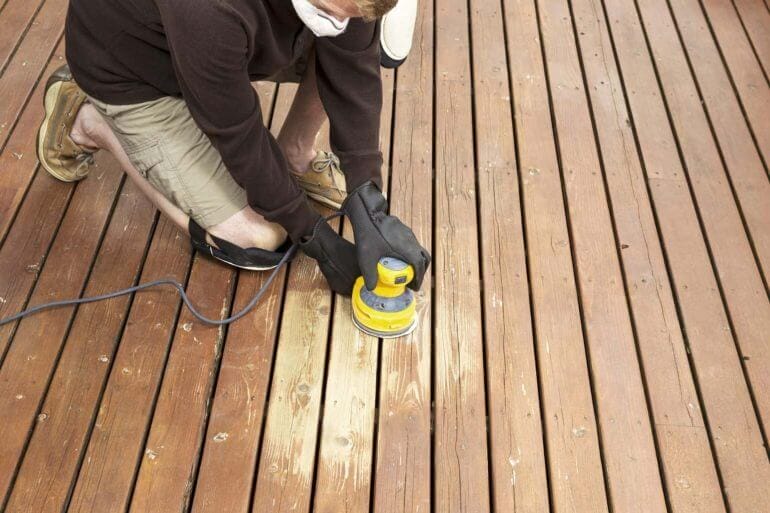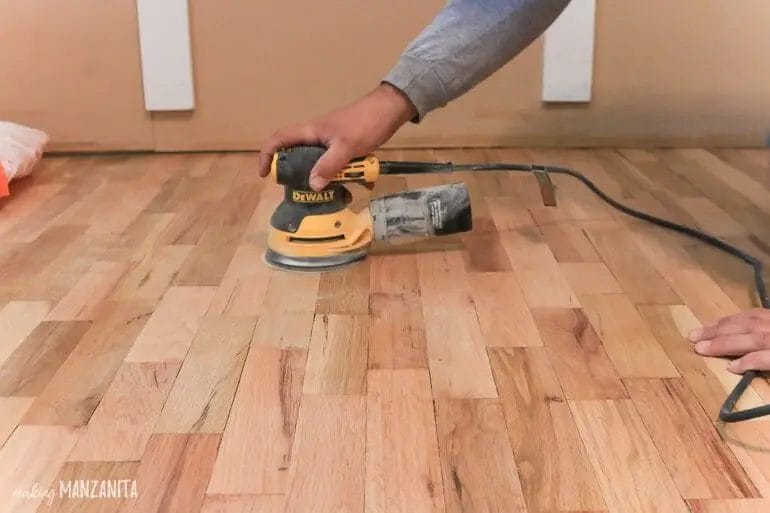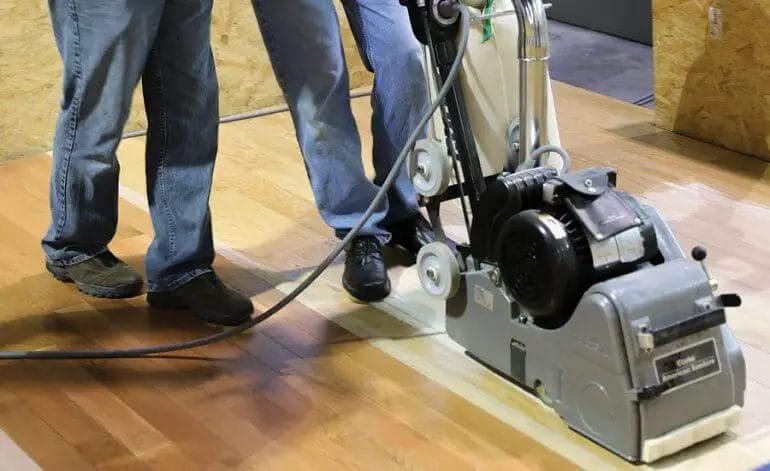If you’re looking to refinish your wood floors, choosing the right grit sandpaper is crucial for achieving a smooth and flawless finish. The grit of sandpaper refers to the size of the abrasive particles on its surface. Generally, a range of grits is used during the sanding process to progressively smooth out imperfections and remove old finishes. Starting with a coarser grit, such as 36 or 40, helps tackle deep scratches and uneven surfaces. As you progress, gradually move to finer grits like 80, 120, and finally 150 or 180 for a polished and ready-to-stain surface.

Understanding the Different Grits of Sandpaper for Wood Floor Refinishing
When it comes to refinishing wood floors, one of the most important steps is sanding. This process involves removing the old finish and smoothing out the surface of the wood to prepare it for a fresh coat of stain or sealant. To achieve the best results, it’s crucial to understand the different grits of sandpaper and how they affect the outcome of your refinishing project.

1. Coarse Grit Sandpaper
Coarse grit sandpaper, typically ranging from 24 to 40 grit, is the most aggressive type of sandpaper. It is used for heavy-duty sanding tasks, such as removing deep scratches, old paint, or previous finishes. This grit level is not suitable for finishing wood floors, as it can leave behind deep grooves and marks.
2. Medium Grit Sandpaper
Medium grit sandpaper, usually ranging from 60 to 100 grit, is the go-to choice for initial sanding after removing the old finish. It effectively smooths out any rough spots or imperfections on the wood surface. Medium grit sandpaper is also used to remove any residual finish or stain that the coarse grit sandpaper might have missed.
3. Fine Grit Sandpaper
Fine grit sandpaper, ranging from 120 to 220 grit, is used for the final sanding before applying a new finish. It helps to create a smooth and even surface, ready for staining or sealing. Fine grit sandpaper removes any remaining imperfections and prepares the wood for a flawless finish.
4. Extra Fine Grit Sandpaper
Extra fine grit sandpaper, typically ranging from 240 to 400 grit, is used for polishing and buffing the wood surface. It is often employed for the final touch-ups in refinishing projects, ensuring a pristine finish. This grit level is not commonly used for general sanding, as it doesn’t remove much material.
Choosing the Right Grit Combination
It’s essential to select the right combination of grits to achieve the desired results in your wood floor refinishing project. Typically, starting with a coarser grit and gradually progressing to finer grits is the best approach. This allows you to smooth out imperfections and gradually refine the surface of the wood.
Here’s a general guideline for selecting the grit combination:
- Start with a 60 to 80 grit sandpaper to remove the old finish and any visible imperfections.
- Follow up with a 100 to 120 grit sandpaper to smooth out the surface further.
- Finish with a 150 to 180 grit sandpaper for a fine, smooth finish.
Keep in mind that the specific grit combination may vary depending on the condition of your wood floor and the desired level of smoothness. It’s always a good idea to test different grits on a small, inconspicuous area before proceeding with the entire floor.
Sanding Techniques
Along with selecting the right grits, using proper sanding techniques is crucial for a successful wood floor refinishing project. Here are some essential tips:
- Sand in the direction of the wood grain to avoid leaving visible scratches.
- Keep the sandpaper level and apply even pressure for consistent results.
- Change the sandpaper regularly to maintain its effectiveness.
- Use a sanding block or a floor sander for large areas to ensure an even sanding pattern.
- Always wear protective gear, such as goggles and a mask, to avoid inhaling dust particles.
In summary, understanding the different grits of sandpaper and their applications is crucial for achieving a successful wood floor refinishing project. Coarse grits are ideal for heavy sanding tasks, while finer grits are used for smoothing and preparing the surface for a new finish. By using the right grit combination and employing proper sanding techniques, you can transform your worn-out wood floors into stunning masterpieces.

The Best Grit Sandpaper for Prepping Wood Floors
When it comes to prepping wood floors for refinishing or repair, using the right sandpaper is crucial. The type and grit of sandpaper you choose can greatly impact the outcome of your project. In this section, we will discuss the best grit sandpaper options for prepping wood floors.
1. 24 Grit Sandpaper
Starting with the most aggressive grit, 24 grit sandpaper is ideal for removing tough coatings, deep scratches, and imperfections from wood floors. This coarse grit quickly levels the surface and prepares it for further sanding. It is important to note that 24 grit sandpaper can leave noticeable scratches, so it should be used as a first step in the sanding process.
2. 36 Grit Sandpaper
Next up is 36 grit sandpaper. This medium-coarse grit is suitable for rough sanding and further leveling the surface after using 24 grit. It effectively removes deeper scratches and old finishes, allowing for a smoother finish in later stages of sanding.
3. 60 Grit Sandpaper
60 grit sandpaper is considered a medium grit and is commonly used for initial sanding or leveling after using coarser grits. It helps to remove scratches, blemishes, and minor imperfections, leaving the wood surface ready for finer sanding.
4. 80 Grit Sandpaper
As we move towards finer grits, 80 grit sandpaper is commonly used for the final stages of sanding before applying a finish. It helps to smooth out the wood surface, removing any remaining scratches or imperfections left by coarser grits.
5. 120 Grit Sandpaper
For a smoother surface and further refinement, 120 grit sandpaper is a good choice. It removes fine scratches and prepares the wood for a final finish. This grit is often used as the last step before applying a protective coating.
6. 220 Grit Sandpaper
If you want an even smoother surface or if you are working with hardwood floors, 220 grit sandpaper is a fine grit option. It helps to achieve a polished look by removing any remaining imperfections and providing a smooth finish.
7. 400 Grit Sandpaper
For an ultra-smooth finish, 400 grit sandpaper can be used as a final sanding step before applying a finish. This extra-fine grit removes very fine scratches and leaves the wood surface ready for a high-quality finish.
It is important to note that the grit sequence mentioned above is a general guideline and may vary depending on the condition of the wood floor and the desired outcome. Always start with a coarser grit and gradually move to finer grits for optimal results.
When using sandpaper for prepping wood floors, it is recommended to use a random orbital sander or a belt sander for larger areas. Hand sanding can be used for smaller or detailed sections.
Remember to wear appropriate safety gear, such as a dust mask and protective eyewear, when sanding wood floors. Proper sanding techniques and using the right grit sandpaper will ensure a smooth, even, and professional result for your wood floor prepping project.

Sandpaper Grit Guide for Achieving a Smooth Finish on Wood Floors
When it comes to refinishing wood floors, sanding is a crucial step in achieving a smooth and professional finish. However, choosing the right sandpaper grit can be a bit overwhelming, especially if you’re not familiar with the process. In this guide, we will walk you through the different sandpaper grits available and help you understand which grit to use at each stage of the sanding process.
1. Coarse Grits (24-60)
Coarse grit sandpaper is used for the initial sanding stage, especially if your wood floors have deep scratches, stains, or uneven surfaces. The coarse grits, ranging from 24 to 60, are highly abrasive and remove a significant amount of material quickly.
During this stage, it’s essential to wear protective gear such as goggles, a dust mask, and ear protection. Start by sanding the floor diagonally to the grain, using a drum sander or a belt sander. This coarse sanding will level the floor and remove imperfections, preparing it for the next stage.
2. Medium Grits (80-120)
After the initial coarse sanding, it’s time to move on to medium grit sandpaper, typically ranging from 80 to 120. Medium grits are used to smooth out the floor further and remove any remaining imperfections left by the coarse grits.
Again, it’s crucial to sand in the direction of the wood grain to achieve an even and smooth finish. Take your time during this stage, as it’s essential to remove all the visible marks left by the coarse sanding. Once you’re satisfied with the smoothness of the floor, you can move on to the final sanding stage.
3. Fine Grits (150-220)
When it comes to the final sanding stage, you’ll want to use fine grit sandpaper, typically ranging from 150 to 220. Fine grits are used to create a polished and smooth surface before applying the finish of your choice.
Sand the floor in the direction of the wood grain, taking care to remove any visible scratches or marks left by the previous sanding stages. As you progress with the finer grits, the floor will start to feel silky smooth, indicating that you’re nearing the desired finish.
4. Extra Fine Grits (240+)
If you’re looking for an exceptionally smooth finish or planning to apply a stain or varnish that requires a flawless surface, you can opt for extra fine grit sandpaper with a grit higher than 240. These grits are incredibly fine and are mainly used for the final sanding stage to achieve the ultimate smoothness.
Remember to sand the floor lightly and in the direction of the wood grain. Take your time and inspect the surface carefully to ensure there are no visible imperfections left. Once you’re satisfied with the smoothness, you can proceed to clean the floor thoroughly before applying the desired finish.
Summary
Choosing the right sandpaper grit is crucial for achieving a smooth finish on wood floors. Starting with coarse grits (24-60) for initial leveling, moving on to medium grits (80-120) for further smoothing, and finishing with fine grits (150-220) for a polished surface. If desired, extra fine grits (240+) can be used for an exceptionally smooth finish. Remember to always sand in the direction of the wood grain and take your time at each stage to ensure a professional result. Happy sanding!
Tips for Using the Correct Grit Sandpaper for Wood Floor Restoration
Restoring a wood floor can breathe new life into your home and enhance its overall aesthetic. One of the most crucial steps in the restoration process is sanding the floor to remove old finish, scratches, and imperfections. Choosing the correct grit sandpaper for this task is essential to achieving the desired results. Here are some tips to help you select the right grit sandpaper for your wood floor restoration project.
1. Evaluate the Condition of the Floor
Before selecting a grit sandpaper, assess the condition of the wood floor. Determine the level of damage, the depth of scratches, and the type of finish that needs to be removed. If the floor has minor imperfections or a thin layer of finish, a fine grit sandpaper might be sufficient. However, for heavily damaged floors or thick layers of finish, a coarser grit sandpaper may be necessary.
2. Start with a Coarser Grit
When beginning the sanding process, it is generally recommended to start with a coarser grit sandpaper. This will help to remove the existing finish and level any deep scratches or stains. A 24 to 36 grit sandpaper is ideal for this initial sanding stage. Be sure to sand in the direction of the wood grain to avoid causing additional damage.
3. Gradually Transition to Finer Grits
After the initial sanding, gradually transition to finer grit sandpapers to achieve a smoother finish. Move from the coarser grits, such as 50 or 60, to medium grits like 80 or 100. These grits will help to refine the surface and remove any remaining imperfections left by the coarser sandpaper. Continue sanding in the direction of the wood grain to maintain a consistent appearance.
4. Consider the Wood Species
The type of wood species also plays a role in determining the correct grit sandpaper to use. Softer woods, such as pine or birch, may require a finer grit sandpaper to avoid causing excessive damage. Harder woods, such as oak or maple, can withstand coarser grits. Consider the hardness of your wood floor and choose the appropriate grit sandpaper accordingly.
5. Finish with a Fine Grit Sandpaper
For the final sanding stage, switch to a fine grit sandpaper to achieve a smooth and polished surface. Grits ranging from 120 to 180 are commonly used for this step. This will help to remove any fine scratches or marks left by the previous sanding stages, resulting in a beautifully restored wood floor.
Remember to always wear protective gear, such as goggles and a dust mask, while sanding to prevent inhalation of dust particles. Additionally, ensure that your sandpaper is clean and free from debris to avoid scratching the wood surface. Taking these precautions and following the tips mentioned above will help you use the correct grit sandpaper for wood floor restoration and achieve outstanding results.
FAQs
What grit sandpaper should I use for wood floors?
The grit sandpaper you should use for wood floors depends on the condition of the floor. For initial sanding or removing deep scratches, start with coarse grits like 24 or 36. For smoother finishes, use grits between 50 and 80. Finally, for fine finishing, use grits between 100 and 120.
How many times should I sand my wood floors?
The number of times you should sand your wood floors depends on their condition and the desired finish. Generally, two to three sanding passes are sufficient. However, if the floor has deep stains or damage, you may need additional passes. It is best to consult professionals for an accurate assessment.
Can I sand my wood floors by hand?
Sanding wood floors by hand is not recommended as it can be time-consuming and physically demanding. It is more efficient and effective to use a floor sander machine, which provides consistent and even results. However, smaller areas or intricate details may require hand sanding to reach those difficult-to-access spots.
Conclusion
In conclusion, choosing the right grit sandpaper for wood floors is crucial to achieve a smooth and flawless finish. By understanding the different grit levels and their applications, you can effectively remove imperfections, scratches, and old finishes from your wood floors.
When starting the sanding process, it’s recommended to use a coarser grit sandpaper like 36 or 60 to remove the topmost layer of the floor. As you progress, gradually switch to finer grits like 80 or 100 for a smoother surface. Finally, finish with a very fine grit like 120 or 150 to prepare the wood for staining or refinishing.
Remember to always sand in the direction of the wood grain and to perform regular cleanings to remove any dust or debris. With the right grit sandpaper and proper technique, you can achieve professional-looking results and restore the beauty of your wood floors.
